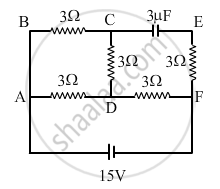Advertisements
Advertisements
प्रश्न
If the potential difference across the ends of a conductor is 220 V and the resistance of the conductor is 44 Ω (ohm), then the current flowing through is _________.
- 0.2 A
- 0.5 A
- 2 A
- 5 A
उत्तर
(d) 5 A
V = IR
∴ 220 V = I x 44 Ω
Or, `"I"=(220"V")/(44Omega)=5"A"`
APPEARS IN
संबंधित प्रश्न
Find the resistance of a conductor if 0.24 A current is passing through it and a potential difference of 24 V is applied across it.
Will current flow more easily through a thick wire or a thin wire of the same material, when connected to the same source? Why?
Is Ohm’s law universally applicable for all conducting elements? If not, give examples of elements which do not obey Ohm’s law.
What is Resistivity?
Write the formula of resistivity
An electrical bulb is marked 200V, 100W. Calculate the electrical resistance of its filament. If five such
bulbs are connected in series to a 200V supply, how much current will flow through them?
Name the physical quantity whose unit is "ohm".
The graph between V and I for a conductor is a straight line passing through the origin.
Which law is illustrated by such a graph?
Which of the following is an ohmic resistance?
In a conductor 6.25 × `10^16` electrons flow from its end A to B in 2 s. Find the current flowing through the conductor (e = 1.6 × `10^-19` C)
A car bulb connected to a 12 volt battery draws 2 A current when glowing. What is the resistance of the filament of the bulb? Will the resistance be more same or less when the bulb is not glowing?
Show by a diagram how two resistors R1 and R2 are joined in parallel. Obtain an expression for the total resistance of the combination.
In the circuit shown in the figure, find the total resistance of the circuit and the current in the arm AD.

Calculate the electric field in a copper wire of cross-sectional area 2.0 mm2 carrying a current of 1 A.
The resistivity of copper = 1.7 × 10–8 Ω m
- Name and state the law which relates the potential difference and current in a conductor.
- What is the necessary condition for a conductor to obey the law named above in part (a) ?
State the relation correlating the electric current flowing in a conductor and the voltage applied across it. Also, draw a graph to show this. relationship.
State and define Ohm’s law.
Draw a neat diagram for the verification of Ohm’s law by voltmeter-ammeter method. By another diagram show the relation between p.d. and current.
Ohm’s law states the relationship between power and voltage.
State microscopic form of Ohm’s law.
What is non ohmic device?
Define temperature coefficient of resistance.
Write a short note on superconductors?
The resistance of a nichrome wire at 0°C is 10Ω. If its temperature coefficient of resistivity of nichrome is 0.004/ °C, find its resistance of the wire at boiling point of water. Comment on the result.
Which of the following I-V graph represents ohmic conductors?
The variable resistance is called ____________.
State Ohm’s law? How can it be verified experimentally? Does it hold good under all conditions? Comment.
The heat produced by a 100 w heater in 2 minute is equal to
A metal rod of length 10 cm and a rectangular cross-section of 1 cm × `1/2` cm is connected to a battery across opposite faces. The resistance will be ______.
State Ohm's Law. Represent it mathematically.
Let the resistance of an electrical device remain constant, while the potential difference across its two ends decreases to one fourth of its initial value. What change will occur in the current through it? State the law which helps us in solving the above stated question.
What is meant by resistance of a conductor ? Define its SI unit.
Why should an ammeter have low resistance?
